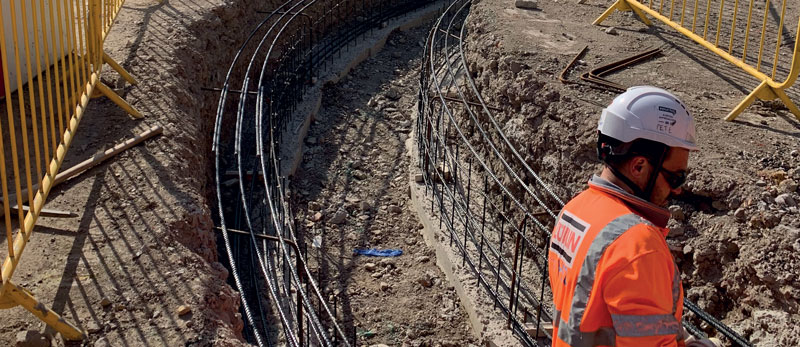Letters to the editor and comments online
Your View
Materials
British standard key to greater uptake of basalt rebar
Following NCE’s recent coverage of basalt fibre reinforced polymer (BFRP), commonly known as basalt rebar (NCE, May), I believe we could be witnessing a completely new era in reinforced concrete with reinforcement that does not corrode.
Clearly, the life of reinforced concrete is limited by the eventual corrosion of the steel reinforcement. This is particularly true of maritime works for which reinforcement that does not corrode would be a game-changing development.
Not only does basalt rebar not corrode, it is 2.5 times the tensile strength and four times lighter than concrete, added to which, it uses less carbon in its manufacture, transportation and installation. It cannot be bent on site so would be delivered to site already bent – with the accuracy of CAD, this should not be a problem. It does have to be protected from long-term exposure to ultraviolet light so it has to be embedded or provided with a suitable protective coating.
The potential use of BFRP reaches far beyond reinforced concrete to other possible uses such as ground or rock anchors and all forms of prestressing – both pre-tensioned and post-tensioned prestressed concrete should be possible which, in the latter, would remove the risk of stress corrosion (hydrogen embrittlement) where there is free hydrogen due to water ingress to an incompletely filled duct.
 Basalt fibre reinforced polymer in use as reinforcement on High Speed 2
Basalt fibre reinforced polymer in use as reinforcement on High Speed 2
I understand that the ICE, in its role as a Learned Society, is to call for papers on the development of this material to be presented at Great George Street to keep members up to date. I also understand that bids for funding for further research would be considered favourably by the ICE Research Fund.
The vital step is to establish one or more British Standards for the new material so that certified material can be specified and used with confidence.
It is hoped that the Institution will form a committee of suitable people with relevant knowledge and experience to work with the BSI to draft appropriate British standards. There is already some experience of use of basalt rebar on site in temporary works. To move to its widespread use in permanent works, a suitable British standard is required urgently.
We are playing catch up. The material has been in use for a number of years in the United States and Canada.
Canada already has a standard for its use to reinforce bridges adversely affected by de-icing salts. This can prolong the life of a bridge, avoiding the need to demolish and replace it with all the attendant disruption and carbon emissions.
The future is bright if this technology can be successfully developed and longer lasting infrastructure would deliver not only a lower carbon future but much better value for money.
Peter Meanley (F), contact details withheld
MATERIALS
Raac: distinction to be made on design life vs lifespan
Several times in recent coverage, NCE refers to reinforced autoclaved aerated concrete (Raac) having a design life of “30 to 40 years”. Similar statements have been made in almost every newspaper, magazine or online article.
As a consulting structural engineer working from the 1970s onwards when Raac products were being marketed and sold by four or five manufacturers, I do not recall that there was any mention of a limited life for these products.
As I said in an interview published in The Times on 4 September, I never used Raac slabs, but this was because of my concerns about the inherently weak and porous autoclaved aerated concrete rather than because of any knowledge of an alleged limited lifespan.
A “design life” is the intended period during which an element is designed to remain serviceable. For UK buildings this would normally be 50 years unless a different period is explicitly stated.
A “lifespan” means the actual period over which an element is serviceable. There is thus a significant difference between “design life” and “lifespan” and it appears that your reports (and the other reports I have seen) are using the incorrect term.
It is of interest to see that Raac roof panels are still being sold, although not in the UK, with absolutely no mention of any limited lifespan – on the contrary the manufacturers are lauding the durability and longevity of Raac.
John Roberts (F), johnmaxwellroberts@hotmail.com